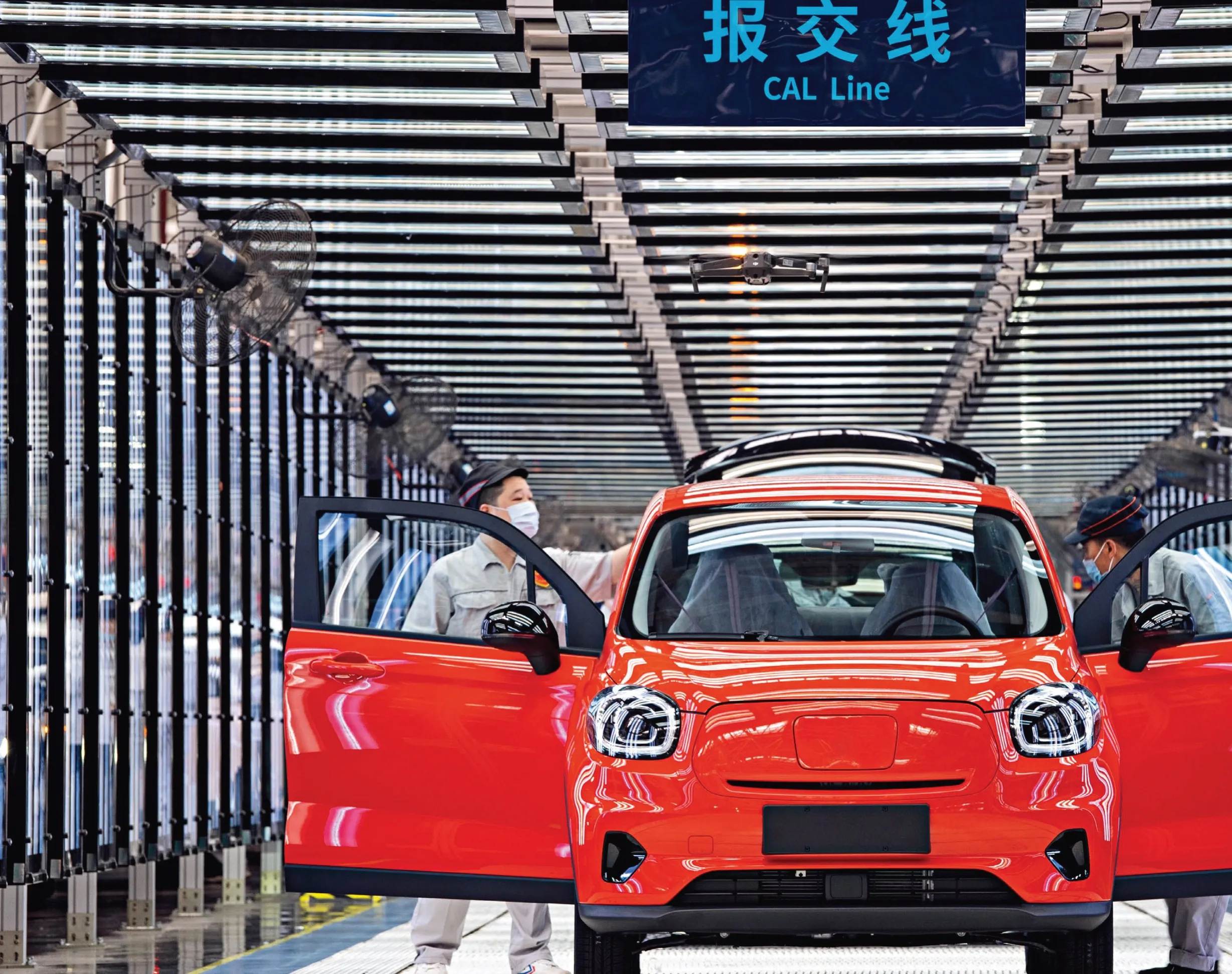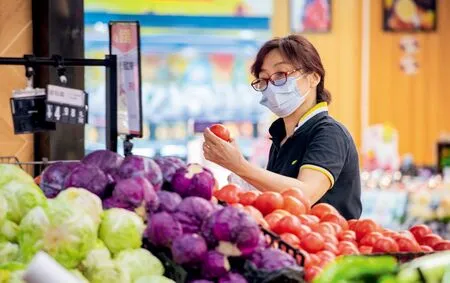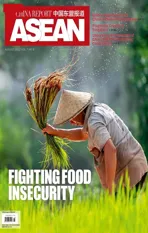Addressing Economic Chanllenges
2022-09-02ByChenKe
By Chen Ke
Despite facing uncertainties both at home and abroad,China has effectively coordinated pandemic control with economic and social development,and its economy is expected to recover in the second half of the year

A new energy vehicle at the end of an assembly line in Jinhua City,Zhejiang Province,April 26,2022.(VISUAL.PEOPLE.CN)
At a July 15 press conference,China’s National Bureau of Statistics (NBS) released data on the country’s economic performance in the first half of this year showing that China’s gross domestic product (GDP) expanded 2.5 percent year on year to 56.26 trillion yuan(US$8.65 trillion).GDP growth in Q2 was 29.25 trillion yuan (US$4.50 trillion),up 0.4 percent year on year.The Chinese economy secured positive growth in Q1 and Q2 despite downward pressure.
NBS spokesperson Fu Linghui said at the press conference that in general,a slew of supportive policies have enabled the Chinese economy to overcome the impact of unexpected domestic and overseas factors.It stabilized and rebounded for positive growth in Q2,which contributed to overall economic stability.“The economic growth didn’t come easily,”said Fu.
Experts said in interviews that China’s economic growth in the first half of the year was basically within the expected range.Driven by policy incentives,some positive changes have taken place with the economic situation.The most difficult period might already be over.The Chinese economy is expected to rebound more dramatically in Q3 and Q4.
Economic Resilience in Q2
The latest data showed that the Chinese economy grew by 4.8 percent in Q1.In Q2,however,the growth rate fell to 0.4 percent.Fu said that since the beginning of this year,the international environment has become more complicated and challenging with the evolving crisis in Ukraine and sporadic outbreaks of COVID-19 around China,even more than what had been expected.Downward pressure on the economy increased significantly in Q2.
“The economic performance in January and February was eyecatching,” said Lian Ping,chief economist with Zhixin Investment,president of Zhixin Investment Research Institute,and president of the China Chief Economist Forum.“In March and April,it was obviously under pressure.In May it began to rebound.Therefore,Q2 might have been the most difficult period of the whole year with the greatest pressure.”
Facing a complicated situation,all localities and all departments effectively coordinated pandemic control and prevention with economic and social development,according to Fu Linghui.The policy package to stabilize the economy has been implemented,the national economy has been stabilized for recovery,momentum for high-quality development has been sustained,and overall social stability has been solidified.He emphasized that the positive growth in Q2 was achieved against the backdrop of a decline in main production demand indicators in April and May,which has not been easy at all.“It demonstrated that the Chinese economy is resilient with great potential,” he said.
“I think investment,especially investment in infrastructure and manufacturing,is playing a key role in stabilizing the macroeconomy,”said Xu Hongcai,deputy director of economic policy at the China Association of Policy Science.Investment in manufacturing has been growing rapidly since last year,and investment in infrastructure has been rising since the beginning of this year.The Purchasing Managers’ Index(PMI),for example,has been climbing continuously in the past two months,to more than 50 percent in June.
It’s also noteworthy that investment in both high-tech industries and high-tech manufacturing grew by more than 20 percent in the first half of the year.The jump reflected optimization of the economic structure and manufacturing structure and evidenced investment growth momentum in relevant sectors.
Xu Hongcai agreed with Lian Ping that policy implementation put the resilience of the Chinese economy front and center.Lian suggested that in the next phase,policy should be used to promote economic growth to ensure the economy resumes its original development momentum.Xu predicted that the economy would maintain growth momentum in Q3 of more than 5 percent.Then,the growth rate in Q4 should be even higher.The average annual economic growth rate will probably exceed 4 percent.
Increasing Pressure on Foreign Trade
NBS data showed that China’s imports and exports of goods increased 9.4 percent year on year in the first half of the year,with exports up 13.2 percent.The trade surplus in June reached a record high of US$97.9 billion.
Today,the global economy faces the risk of stagnation.According to Xu Hongcai,Germany,an established manufacturing power,has suffered from trade deficits for the first time in nearly 30 years alongside Japan,UK,and France.“However,China’s trade surplus has expanded,demonstrating the high competitiveness of its manufacturing industry,the strength of its exports,and the resilience of its industrial chain,” said Xu.“It has also been a big contributor to the international community.”
It should be noted that China’s imports and exports in the second half of the year may face some uncertainties.“The current weakness in imports reflects a lack of domestic demand,” said Xu.“Both the Federal Reserve and the European Central Bank will raise interest rates further in July,so China’s exports are likely to fall.One reason for the remarkable export data in May and June was an accumulation of orders.Therefore,we should not be too optimistic about the situation for foreign trade in Q3 and Q4.”
Lian Ping cautions that conversely,interest rate hikes may affect the world economy more in Q4.The global economic slowdown is bound to lead to a decline in trade growth.“As a major exporter,China is going to face more pressure on its foreign trade in Q4 than in Q3.”
In terms of consumption,the sporadic outbreaks of the pandemic have continued to restrict people’s travel and consumption.Data showed that total retail sales of consumer goods fell 0.7 percent year on year.The growth curve showed that the rate in the first two months of the year was 6.7 percent,negative from March to May,and bouncing back from the bottom to 3.1 percent in June.
Lian Ping sees favorable external conditions for consumption growth in the second half of the year with production and business activities resuming slowly and incentive policies rolling out.He predicts that in the second half of the year,especially in Q3,more stimulus packages will be available including consumption vouchers and incentives for automobile consumption.
“In the second half of the year,we will see more scenarios like festivals and various activities to facilitate consumption,” said Lian Ping.“Consumption is expected to return to positive growth in Q3 and grow further in Q4.” However,Lian also admitted that it would be impossible for consumption to reach the prepandemic level because the pandemic will continue to curb consumer behavior periodically.
In the first half of this year,the floor space and volume of commercial housing sales fell by 22.2 percent and 28.9 percent,respectively.Lian believes that alongside the negative impact of the pandemic on consumption,the real estate downturn is also exerting downward pressure on the economy.
Recently,homeowners in several localities announced refusal to make mortgage payments because delivery of their properties had been delayed,which has caused concern.The China Banking and Insurance Regulatory Commission (CBIRC) responded that it would guide financial institutions to strengthen market-based participation in risk management.All interviewed experts agreed that the phenomenon is currently local and that the risk is still controllable.However,avoiding problems doesn’t solve anything.Effective measures should be taken to prevent the risk from spreading to banks and the entire financial system.
Responding to External Risk
At the press conference,Fu Linghui looked ahead to China’s economic situation in the second half of the year.With the pandemic coming under control and incentive policies effectively implemented,the Chinese economy’s advantages such as its sheer size,enormous market,resilient development,reform dividends,and strong governance capacity will be leveraged.The Chinese economy is expected to continue to recover.Meanwhile,Fu also recognizes many lingering external uncertainties coupled with the triple pressure of demand contractions,supply shock,and weakening internal expectations.
Xu Hongcai predicted some challenges and risks in the second half of the year.First,inflation imported from the international community should not be taken lightly.“At present,the prices of grain,oil,natural gas,coal and other commodities are rising,with some of the factors out of our control,” said Xu.

Tourists at Pishi Street Night Market in Yangzhou,Jiangsu Province,May 22,2022.(MENG DELONG)

A shopper at a grocery store in Nanjing,Jiangsu Province,June 10,2022.(SU YANG)
The US just released its Consumer Price Index (CPI) for June: After rising more than 8 percent for three consecutive months,it increased 9.1 percent in June,pushing the index to the highest level in 41 years.Analysts believed that the continued high inflation rate would reinforce market expectations for the Federal Reserve to raise interest rates significantly.“Federal Reserve interest rate hikes will cause depreciation pressure on Chinese currency,” said Xu.“When the global financial system fluctuates,we have to be vigilant about imported financial risk.”
Lian Ping is also concerned that global inflation will create imported inflation for China.The Federal Reserve interest rate hikes will impact the exchange rate and capital flow of Chinese currency.The decline of world economic growth in the second half of the year will more likely have a big impact on Chinese exports.
In terms of the supply chain,both external and internal disruptions have occurred.Xu Hongcai cited examples of the Russia-Ukraine conflict and the US attempt to restructure the global supply chain,both of which have to some extent poisoned the external environment.Internally,rigid pandemic control and prevention measures in some severely affected regions have obstructed the smooth flow of the supply chain.
“We must continue to stabilize the supply chain and industrial chain because they are associated with the real economy,” said Xu,noting the recent outbound transfer of some foreign-invested enterprises from the Guangdong-Hong Kong-Macao region and the Yangtze River Delta region.“Although this is not yet a wave,we have to pay attention to the trend before it becomes one.”
Alongside the above challenges,other adverse internal factors were also mentioned by the experts.Examples included the climbing youth unemployment rate,stabilization of 160 million market entities,and more.In response to a question on the possibility of achieving GDP growth target of 5.5 percent this year,Fu Linghui said that in the second half,with effective pandemic control and economic and social development,as well as the implementation of various stabilization policies,Chinese economy will continue to recover,running within an appropriate range.
Lian Ping once predicted that accelerated implementation of proactive fiscal policies,prudent monetary policies,and various incentive policies would ensure China’s GDP grows by around 4.8 percent annually.With strong support from incentive policies,growth can exceed 5 percent and near or reach the target to maintain faster growth compared to other major economies.
Xu Hongcai thinks that all the necessary incentive policies are in place for economic recovery in all sectors.But maintaining consistency and strengthening supervision of implementation must continue.
杂志排行
China Report Asean的其它文章
- Cross-border E-commerce Boosts China-ASEAN Agricultural Cooperation
- OVERCOMING THE FOOD CRISIS TOGETHER
- FAO Official Urges Countries Not to Impose Food Export Restrictions
- Unlocking the Potential of China-ASEAN Wind Power Cooperation
- What’s Next For Sri Lanka
- The Block-by-block Revival of an Ancient Chinese Building Technique
